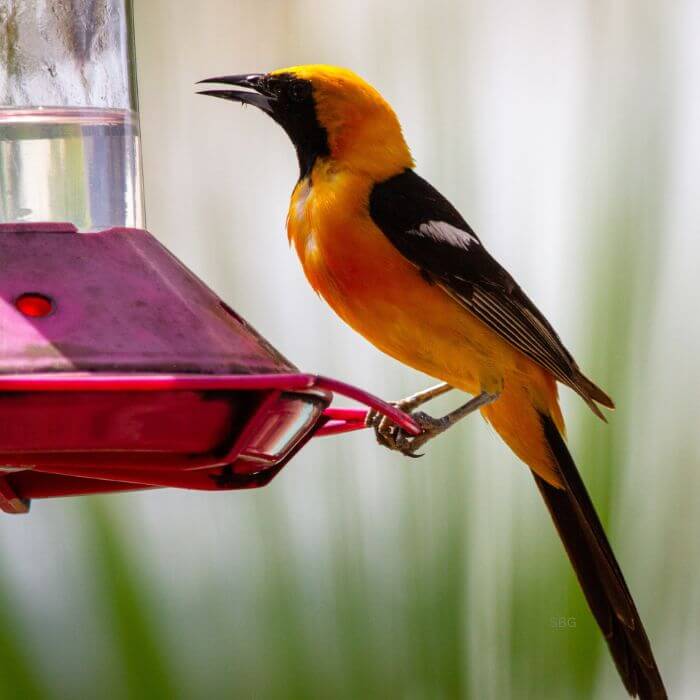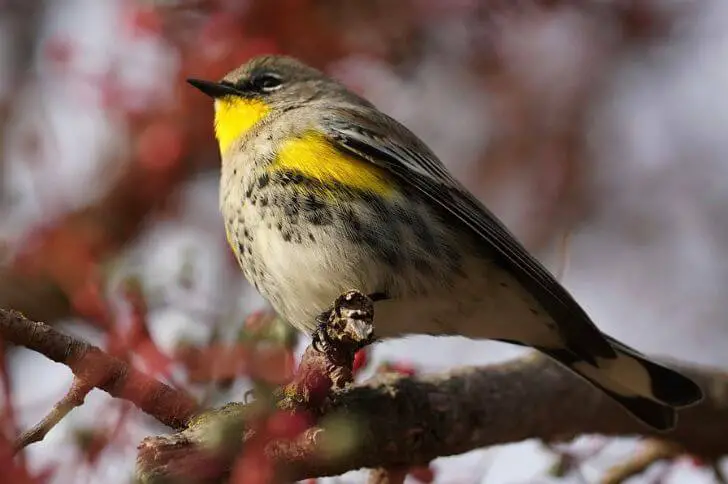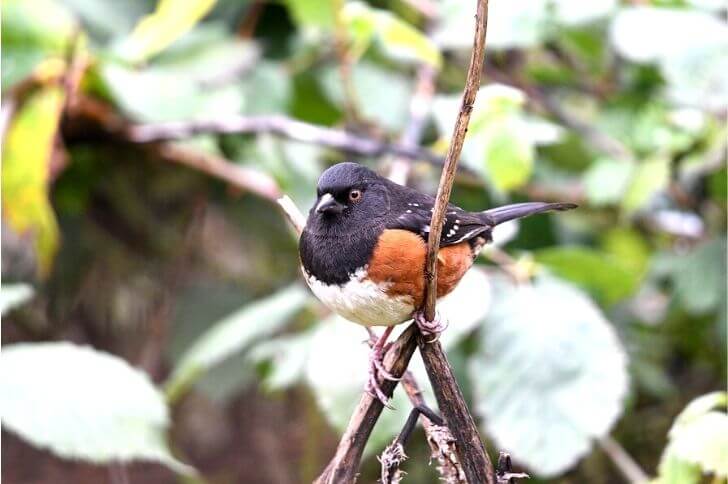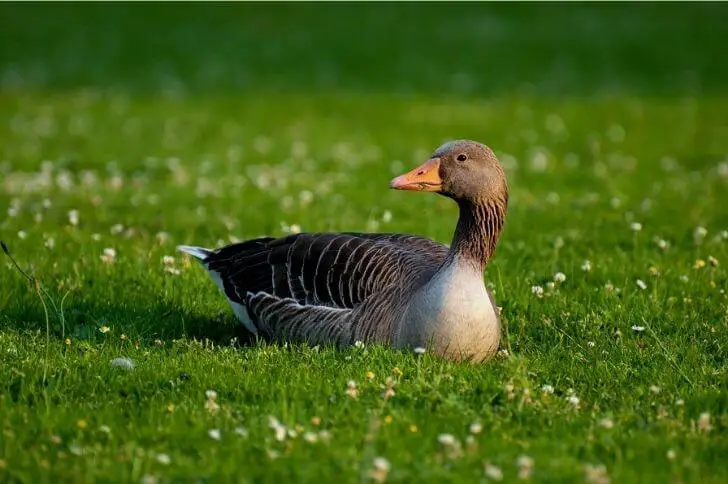There are many different types of birds in California, but some of the most striking are the yellow and black birds. Some of these birds are native to California and can be found in many different parts of the state. Others are migratory birds, coming to the state every other season.
Below we’ll look at different yellow and black birds of California. From the hooded oriole to the common yellow throat, there are enough names to add to your must-see birds list. These unique birds are a very important part of the ecosystem in California and play a vital role in the food chain. They are also a popular choice for birdwatchers and photographers.
Yellow and Black Bird California
1. Yellow-headed Blackbirds

Yellow-headed Blackbirds – Xanthocephalus xanthocephalus
Ever seen a yellow-headed blackbird? If not, here are its distinctive features to help you identify this species easily.
Identification:
The yellow headed blackbird is a beautiful bird that is found in California. The male has a black body with a bright yellow head and breast. Note the black face mask and white on wings.
The female yellow-headed blackbird has a brownish body with a pale yellow head. Both sexes have short canonical bills and dark legs.
Other facts:
These birds are found in marshy areas and often build their nests in cattails. Their breeding season starts from April to mid-July. The female builds a cup-shaped nest, later she lays 2-5 greenish eggs with brown splotches.
After two weeks the eggs hatch revealing naked nestlings that are blind with bright red mouths. At about two weeks, the babies are able to leave the nest. Yellow-headed blackbirds live up to 11 years.
The yellow headed blackbird is an important bird for controlling insect populations. These birds will eat large quantities of insects, which helps to keep the insect population under control. The yellow headed blackbird is also an important seed disperser and helps to spread native plants throughout their range.
2. Hooded Oriole

Hooded Oriole – Icterus cucullatus
Hooded orioles are small yellow birds of California that can be found in woodlands, gardens, and parks.
Identification:
The adult male has a bright orange body with black wings, throat and tail, while the female is more drab in color. Both white wing bars and long slender bodies. Also males have dark bills while females are pale.
Young males have similar plumage as females but with a black throat.
Interesting facts:
The hooded oriole feeds on insects and nectar, and builds its nest in tree branches. This friendly bird is often seen flitting about in search of insects to eat or nectar to drink.
It is also a beautiful little bird that brings a splash of color to any backyard it visits. You can attract these bird species to your backyard using jelly or oranges.
If you’re lucky enough to spot a hooded oriole, take a moment to enjoy its beauty before it flies away again.
3. Yellow-rumped Warblers

Yellow-rumped Warblers – Setophaga coronata
California is home to many different types of warblers, and the yellow-rumped warbler is one of the most common.
Identification:
These small birds are easily identified by their yellow rumps. They also have a white throat and black face mask. Females are duller and you may note some pale brown coloring on their bodies.
The adult is 4.7-5.5 inches long with a wingspan of up to 9.1 inches. They are the same size as most chickadees.
Other facts:
These small black and yellow birds can be found in a variety of habitats and range from Northern to Southern California. Although they are not the most colorful warbler, they make up for it with their beautiful singing voices.
The song of the yellow-rumped warbler includes soft sweet trills and warbles.
Yellow rumped warblers are one of the few warbler species that can survive the cold winters in North America, thanks to their ability to eat berries and other fruits. If you’re lucky enough to spot one of these little birds, you’re sure to be charmed by their beauty and grace.
4. American Yellow Warbler

American Yellow Warbler – Setophaga petechia
Favoring cottonwoods and willows, the American yellow warbler is a cute little bird that is found throughout California.
Identification:
These warblers are a bright lemon yellow with a touch of green on their backs. Notice the reddish streaks on their underparts and some black on their wings. The male and female look very similar, but the males usually have a brighter plumage.
Other facts:
These warblers are found in woodlands, forests, and wetlands where they build their nests in trees or shrubs. They eat insects and spiders, which they catch by flying from branch to branch in search of food.
You can find their nests on willows, white cedars, and raspberry trees. Females build the nest and are known to abandon nests and eggs if they find cowbirds eggs. Their greenish-white eggs hatch after two weeks. American yellow warblers can live up to 11 years and prefer the woods to backyards.
They are also a popular bird among birdwatchers because of their bright plumage and cheerful songs.
Related Read: Learn about Birds in San Antonio Texas
5. Scott’s Oriole

Scott’s Oriole – Icterus parisorum
Few birds in California stand out as the Scott’s Oriole; the male of this bird species. Here is how you can identify this yellow bird.
Identification:
The Scott’s oriole is a medium sized, 9.1 inches, icterid blackbird. It is a member of the genus Icterus which includes other popular yellow and black birds.
The male scott’s oriole is slender with an all-black head, throat and chest. Its wings are also black with white wing bars. The rest of the body is a bright yellow. Notice the black outer tail feathers.
On the other hand, scott’s oriole females spot dull yellow underparts, olive green upperparts, brown wings with white wing bars. Both sexes have sharp, slightly curved bills.
Other facts:
The bird was named after William Scott, an English naturalist who collected the first specimens in the 1800s.
These yellow brights prefer desert-like conditions. You can find them in areas with plenty of yucca, juniper and agave. During nesting season, the female scott’s oriole finds the nesting site and constructs a nest out of plant fiber and yucca fiber.
Their eggs are pale blue with stripes at the end. What song does the scott’s oriole sing? Listen for sweet melodies. Also, their calls are a series of “wheet” and “chuk” sounds.
6. Cedar Waxwing

Cedar Waxwing – Bombycilla cedrorum
Though not all black, this gorgeous bird of California makes it to our list because it has some of this shade on its body.
Identification:
The adult features a pale brown head with a crest. This brown coloring spreads to its breast then transitions to a soft yellow belly. The upper back is also brown and the color changes to a pale gray on the wings and lower back. Note the yellow-tipped gray tail.
On average, the adult is about 6.5 inches long. It has a wide bill, short neck, and pointed wings that span up to 11 inches.
Other facts:
The cedar waxwing is a social bird and often forms flocks with other birds. The bird feeds on insects and fruits, and sometimes nectar. The cedar waxwing is not migratory, but some birds may move to higher elevations in the winter.
7. Canada Warbler

Canada Warbler – Cardellina canadensis
With beady eyes and a long tail, the Canada warbler is one of the most fascinating yellow and black California birds you can watch.
Identification:
It is a member of the New World warbler family. It is a small songbird with a chunky body and long tail.
Adults have different features that make it easy to identify them. Adult males have a blue gray hood and back, bright yellow throat, chest is also yellow with black markings. Note the underrump is a pale yellow.
Females Canada warblers are duller with faint markings on their breast.
Interesting facts:
The Canada warbler is found in California, breeding in the boreal forests of Canada and wintering in the southern United States. This warbler is migratory, traveling up to 3,000 miles each year between its breeding and wintering grounds.
The Canada warbler is an insectivore, feeding on insects such as beetles, flies, and caterpillars. This warbler forages for food in the Understory layer of forests, often using its long beak to probe into crevices and leaf litter for prey.
8. Common Yellowthroat

Common Yellowthroat – Geothlypis trichas
The common yellowthroat is a beautiful little bird that is found in many parts of California.
Identification:
The male common yellowthroat has a bright yellow under and a black face mask with a white stripe. Its back is olive green with a long rounded tail. Females are brownish above and bright yellow on the throat and breast. Both sexes have cute beady eyes.
Other facts:
These birds are often seen flitting about in open fields or near roadsides, where they feed on insects.
Their eggs are white with reddish-brown or black splotches. They measure about 0.6-0.8 inches and need about 12 days of incubation.
Common yellowthroats can live up to 11 years. Cowbirds are known to lay eggs in this bird species nest.
9. Western Tanagers

Western Tanagers – Piranga ludoviciana
With bright yellow rumps and beautiful melodious songs, western tanagers are small pretty birds that frequent bird feeders across California.
Identification:
The male western tanager has a yellow body with black wings and a redhead. The female western tanager has a greenish-yellow body with blackish wings.
Other facts:
The western tanager is a member of the songbird family and is known for its beautiful singing voice. They have ratting calls and they sing short songs that last for about 2 seconds. The song is similar to the American robins.
10. Evening Grosbeak

Evening Grosbeak – Hesperiphona vespertina
The evening grosbeak is a beautiful bird that is often seen in California. This bird is a member of the finch family, birds known for uneven warbles.
Identification:
The evening grosbeak was first seen in North America in the early 1800s, and it quickly became a popular bird among birdwatchers.
Adult male evening grosbeaks are yellow and black with a prominent white patch on its head and white on their wings.
Females spot gray feathers and black wings. Both birds have white thick bills and reddish feet.
Interesting facts:
This bird prefers to nest in coniferous trees, and it often builds its nest near streams or lakes. When it comes to breeding habits, the female finds the materials needed to weave a nest and she does most of the weaving.
Then she’ll lay 2-5 blue green eggs with some brown blotches that she’ll sit on for about two weeks.
You can attract these yellow and black birds of California using sunflower seeds. Also they prefer platform feeders. The evening grosbeak is an important seed-eater, and it plays a vital role in the ecosystem.
11. Magnolia Warbler

Magnolia Warbler – Setophaga magnolia
Magnolia warblers are beautiful little birds that are most often seen in wooded areas near streams and rivers.
Identification:
The male Magnolia warbler has a gray cap, black face mask, yellow throat, black neck band and black wings with white wing bars. Below, he is a bright yellow with thick black streaks.
The female Magnolia warbler is not as brightly colored as the male, but is still easily recognizable by her grayish-brown upper body and yellowish lower body. Both birds have white eye rings. On average, their bodies are about 5 inches long with a span of up to 7 inches.
Interesting facts:
These birds are not often seen in urban areas, but can sometimes be found in parks or gardens. The Magnolia warbler eats insects, spiders, and other small invertebrates.
The best time to see a Magnolia warbler is during the spring migration season. You can find them in dense vegetation picking insects.
12. Wilson’s warbler

Wilson’s warbler – Cardellina pusilla
With a lifespan of up to 8 years, the Wilson’s warbler is a beautiful yellow bird of California that can easily fit in your palm.
Identification:
The Wilson’s Warbler is a beautiful little bird that is found in North America. It is a member of the wood-warbler family and is closely related to the yellow-rumped warbler.
An adult bird is about 3.9-4.7 inches long, making it smaller than the adult black-capped chickadee. The male has a bright yellow head with a black cap, yellow underparts and brown wings. Females are duller and without a cap.
Interesting facts:
The Wilson’s Warbler was named after the famous ornithologist Alexander Wilson. He was the first to describe the species and observed them in Pennsylvania in the early 1800s.
This small yellow and black bird California prefers the understory where you can spot it picking insects.
During their nesting season, females can construct the nest on the ground or in shrubs. They then lay up to 7 eggs that are incubated for two weeks.
13. American Goldfinch

American Goldfinch – Spinus tristis
The American goldfinch is a small, cheerful bird that is found across North America. In California, three subspecies of this yellow bird can be found in the wild; the willow goldfinch, the northwestern goldfinch and the pale goldfinch.
Identification:
The subspecies share some features but the slight difference in plumage will help you tell them apart. An adult bird of this yellow bird is about 5 inches with a span of up to 8 inches.
Males have a black cap and wings with white marks, white undertail coverts and orange bill. The rest of the body is bright yellow. Females have a duller yellow head, black wings with bold white wing bars, a black and white tail and the rest of the body is brown.
To tell the subspecies apart; Willow goldfinch are browner in winter and the male bird has a smaller cap compared to males from the other two subspecies.
Northwestern goldfinches prefer central California. They are smaller and darker. The pale goldfinch has a paler yellow color on their body.
Other facts:
Goldfinches are social creatures that often flock together in small groups. They are most commonly seen near open fields and meadows where they can find plenty of seeds to eat. Goldfinches are fun to watch and make excellent backyard birding companions.
14. Lesser Goldfinch

Lesser Goldfinch – Spinus psaltria
Related to the American goldfinch above, the lesser goldfinch is a small finch that was first described in 1822.
Identification:
The adult male has two distinctive morphs. He can have lemon yellow underparts, a black cap and greenish upperparts. Also, a lesser goldfinch male can have an all black back and bright yellow below.
Females and juveniles are similar, brown overall with a yellowish head, but lack the black cap. This bird species has a notched tail and short canonical bill.
Other facts:
These birds are often found in open woodlands and brushy areas, where they feed on seeds and insects. The lesser goldfinch is a common bird across its range, and is not considered to be at risk of extinction.
15. Western Meadowlark

Western Meadowlark – Sturnella neglecta
With a long slender bill and a flat head, the western meadowlark is a wild yellow and black bird in California that is easy to spot.
Identification:
What are the colors of this unique bird of CA? The adult bird has a yellow breast with black V-shaped necklace, and a brown back with black markings. Note the bright yellow stripe around its eyes.
The male and female birds look similar, but the male has a brighter yellow breast. The western meadowlark is about 9 inches long, with a wingspan of about 16 inches. It eats insects, berries, and seeds.
Other facts:
The western meadowlark is a singing bird of the grasslands. Its beautiful song consists of flute-like notes that rise and fall in pitch. The song is often used to declare ownership of a territory. The bird’s nesting behavior is interesting; the female builds the nest on the ground, but the male helps to incubate the eggs and care for the young chicks.
16. Townsend’s Warbler

Townsend’s Warbler – Setophaga townsendi
Townsend’s warbler is a small songbird that was first described by John Townsend in 1839. The bird is found in western North America, from Alaska to California and east to Montana and Wyoming. The Townsend’s warbler is a fairly common bird, with a population of over 1 million birds.
Identification:
The Townsend’s warbler is a small, streaked songbird. The adult bird has a yellow-black head and breast, with olive-green upperparts and dark wings.
The belly and undertail are white, and the tail is black with white stripes. Males and females look similar, although the female may have duller colors.
Other facts:
The Townsend’s warbler breeds in coniferous forests, often near streams or other wet areas. The nest is built by the female, who also incubates the eggs and cares for the young birds. Both parents feed the nestlings.
17. Yellow-bellied Sapsucker

Yellow-bellied Sapsucker – Sphyrapicus varius
Yellow-bellied sapsuckers are North American woodpeckers that range from southern Canada to California.
Identification:
These birds are easily identified by their pale yellow bellies and black and white plumage. To tell the sexes apart, males have a red throat while females have a black throat.
Other facts:
They are one of the few birds that are known to consume sap while looking for insects. Sapsuckers drill small, shallow holes in trees and then return to these same spots to feed on the sap that flows from them.
They also eat insects, berries, and fruits. In addition to drilling holes in trees, sapsuckers also strip bark from branches and tree trunks. This behavior often leaves behind a telltale spiral pattern of small holes.
While sapsuckers can be found in many different types of habitats, they seem to prefer forests with deciduous trees.
18. Lawrence Goldfinch

Lawrence Goldfinch – Spinus lawrencei
Lawrence Goldfinch is a striking bird that is found in open woodlands and scrublands of California.
Identification:
The adult male has a gray body with yellow breast and wings and a black mask. Females are the same color without the yellow breast and black cap.
Both sexes have canonical bills. The goldfinch is a finch of the family Fringillidae, and is native to parts of California. The bird measures about 4 inches in length.
Other facts:
The goldfinch is an important seed predator, and its diet consists mainly of thistle seeds. In winter, when thistle seeds are scarce, the goldfinch will also eat other small seeds, such as those of dandelions and sunflowers.
FAQs:
What wild birds are yellow and black?
These birds include male hooded orioles, yellow headed blackbirds, Scott’s oriole, yellow-rumped warblers, western tanagers and common yellowthroats.
What bird has a yellow chest California?
Various birds have yellow chests including Lawrence goldfinch, lesser goldfinch, Canada warbler, and Evening grosbeak.
What is a yellow and black bird California?
Yellow and black birds in California include Townsend warblers, Canada warbler, hooded oriole, yellow-headed blackbird and magnolia warbler.
Sources:
https://www.allaboutbirds.org/guide/Common_Yellowthroat/id
https://www.audubon.org/field-guide/bird/yellow-headed-blackbird
https://en.wikipedia.org/wiki/Magnolia_warbler
Hi, my name is Steve. My friend and I started the spanishbirdguides.com to share our passion with other like-minded people. So, if bird watching is your thing, you’ll love this blog. I’ll share what I’ve learnt about both local birds and those found in other parts of the world. Also, I’d love to hear your experiences.



